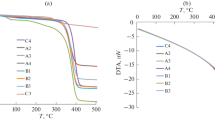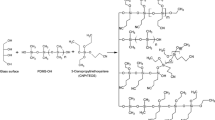Abstract
A novel solid-phase microextraction (SPME) coating is presented that uses polybenzimidazole (PBI) as a binder to immobilize micro-size sorbent particles onto a support. An evaluation of the developed binder’s thermal and solvent desorption capabilities demonstrated its compatibility with both gas and liquid chromatography (GC and LC). The incorporation of hydrophilic-lipophilic balanced (HLB) particles provided optimal extraction coverage for an array of chemically diverse analytes possessing a range of hydrophobicities and molecular weights. The developed binder’s performance was assessed by comparing it to a selection of binders commonly used in the literature, including polydimethylsiloxane (PDMS) and polyacrylonitrile (PAN), as well as the more recently developed polyvinylidene fluoride (PVDF) and polytetrafluoroethylene amorphous fluoroplastic (PTFE AF 2400). The results revealed that PBI provides better performance compared to PVDF and PTFE AF 2400 in terms of its environmental impact, while also being convenient for use in coating preparation and offering good matrix compatibility. The thermal analysis revealed that PBI exhibited more than 93% weight retention at 550 °C, which is superior to PVDF’s 80.07% weight retention at 393.78 °C. To the best of our knowledge, this work is the first to use PBI as a particle binder in SPME coatings. The PBI coating maintained high extraction efficiencies under extreme conditions with pH values of 3 and 12. The performance of PBI in combination with HLB was assessed by employing it to extract several drugs of abuse and McReynolds compounds for LC and GC analysis, respectively. The results indicated that PBI performs similarly to PAN for LC but is outperformed by PDMS in GC applications with respect to extraction and desorption kinetics. Nonetheless, the thermal and solvent desorption results indicated that PBI can be used for both applications, as it remains stable at temperatures over 350 °C and is stable when solvent desorption is applied.
Graphical abstract





Similar content being viewed by others
Data availability
Data sets generated during the current study are available from the corresponding author on reasonable request.
References
Reyes-Garcés N, Gionfriddo E, Gómez-Ríos GA et al (2018) Advances in solid phase microextraction and perspective on future directions. Anal Chem 90:302–360. https://doi.org/10.1021/acs.analchem.7b04502
Delińska K, Rakowska PW, Kloskowski A (2021) Porous material-based sorbent coatings in solid-phase microextraction technique: recent trends and future perspectives. TrAC - Trends Anal Chem 143:116386. https://doi.org/10.1016/j.trac.2021.116386
Lashgari M, Yamini Y (2019) An overview of the most common lab-made coating materials in solid phase microextraction. Talanta 191:283–306. https://doi.org/10.1016/j.talanta.2018.08.077
Delińska K, Machowski G, Kloskowski A (2022) Development of SPME fiber coatings with tunable porosity for physical confinement of ionic liquids as an extraction media. Microchem J 178:107392. https://doi.org/10.1016/j.microc.2022.107392
Murtada K (2020) Trends in nanomaterial-based solid-phase microextraction with a focus on environmental applications - a review. Trends Environ Anal Chem 25:e00077. https://doi.org/10.1016/j.teac.2019.e00077
Nazdrajić E, Murtada K, Pawliszyn J (2021) The effect of sorbent particles in a binder on the mass transfer kinetics in separation media: in silico study and experimental verification. Anal Chem 93:14764–14772. https://doi.org/10.1021/acs.analchem.1c03373
Murtada K, Galpin V, Grandy JJ et al (2021) Development of porous carbon/polydimethylsiloxane thin-film solid-phase microextraction membranes to facilitate on-site sampling of volatile organic compounds. Sustain Chem Pharm 21:100435. https://doi.org/10.1016/j.scp.2021.100435
Liu J-W, Murtada K, Reyes-Garcés N, Pawliszyn J (2020) Systematic evaluation of different coating chemistries used in thin-film microextraction. Molecules 25:3448. https://doi.org/10.3390/molecules25153448
Yu J, Xu XB, Murtada K, Pawliszyn J (2022) Untargeted analysis of microbial metabolites and unsaturated fatty acids in salmon via hydrophilic-lipophilic balanced solid-phase microextraction arrow. Food Chem 380:132219. https://doi.org/10.1016/j.foodchem.2022.132219
Murtada K, Bowman D, Edwards M, Pawliszyn J (2022) Thin-film microextraction combined with comprehensive two-dimensional gas chromatography time-of-flight mass spectrometry screening for presence of multiclass organic pollutants in drinking water samples. Talanta 242:123301. https://doi.org/10.1016/j.talanta.2022.123301
O’Neal KL, Zhang H, Yang Y et al (2010) Fluorous media for extraction and transport. J Chromatogr A 1217:2287–2295. https://doi.org/10.1016/j.chroma.2009.11.077
Lu D, Weber S (2014) Fluorous receptor-facilitated solid phase microextraction. J Chromatogr A 1360:17–22. https://doi.org/10.1016/j.chroma.2014.07.060
Gionfriddo E, Boyacl E, Pawliszyn J (2017) New generation of solid-phase microextraction coatings for complementary separation approaches: a step toward comprehensive metabolomics and multiresidue analyses in complex matrices. Anal Chem 89:4046–4054. https://doi.org/10.1021/acs.analchem.6b04690
Stahl T, Mattern D, Brunn H (2011) Toxicology of perfluorinated compounds. Environ Sci Eur 23:1–52. https://doi.org/10.1186/2190-4715-23-38
Tsai WT (2005) Environmental risk assessment of hydrofluoroethers (HFEs). J Hazard Mater 119:69–78. https://doi.org/10.1016/j.jhazmat.2004.12.018
Sun M, Wu Q, Wang C, Wang Z (2014) Thin-film microextraction for the preconcentration of some endocrine disrupting chemicals in aqueous samples before chromatographic analysis. Anal Methods 6:6316–6321. https://doi.org/10.1039/c4ay00284a
Jafari Z, Hadjmohammadi MR (2021) Polyvinylidene difluoride film with embedded poly(amidoamine) modified graphene oxide for extraction of chlorpyrifos and diazinon. Microchim Acta 188:1–11. https://doi.org/10.1007/s00604-020-04694-w
Singh V, Ghosh C, Kaur A, Pawliszyn J (2020) Polyvinylidene difluoride: a universal binder for preparation of solid phase microextraction devices. ChemRxiv 1–35. https://doi.org/10.26434/chemrxiv.12959885.v1
Jafari Z, Hadjmohammadi MR (2020) In situ growth of zeolitic imidazolate framework-8 on a GO-PVDF membrane as a sorbent for thin-film microextraction of caffeine followed by quantitation through high-performance liquid chromatography. Anal Methods 12:1736–1743. https://doi.org/10.1039/d0ay00137f
Shi Y, Chen L, Huang J et al (2020) The effect of different binders on the comprehensive performance of solid phase microextraction fiber. Anal Chim Acta 1140:50–59. https://doi.org/10.1016/j.aca.2020.09.048
Shi GM, Yang T, Chung TS (2012) Polybenzimidazole (PBI)/zeolitic imidazolate frameworks (ZIF-8) mixed matrix membranes for pervaporation dehydration of alcohols. J Memb Sci 415–416:577–586. https://doi.org/10.1016/j.memsci.2012.05.052
Lu W, Yuan Z, Zhao Y et al (2018) Advanced porous PBI membranes with tunable performance induced by the polymer-solvent interaction for flow battery application. Energy Storage Mater 10:40–47. https://doi.org/10.1016/j.ensm.2017.08.004
Cong S, Wang J, Wang Z, Liu X (2021) Polybenzimidazole (PBI) and benzimidazole-linked polymer (BILP) membranes. Green Chem Eng 2:44–56. https://doi.org/10.1016/j.gce.2020.11.007
Jean-Fulcrand A, Masen MA, Bremner T, Wong JSS (2017) High temperature tribological properties of polybenzimidazole (PBI). Polymer (Guildf) 128:159–168. https://doi.org/10.1016/j.polymer.2017.09.026
Zarrin H, Jiang G, Lam GYY et al (2014) High performance porous polybenzimidazole membrane for alkaline fuel cells. Int J Hydrogen Energy 39:18405–18415. https://doi.org/10.1016/j.ijhydene.2014.08.134
Zhou Z, Zholobko O, Wu XF et al (2021) Polybenzimidazole-based polymer electrolyte membranes for high-temperature fuel cells: current status and prospects. Energies 14:135. https://doi.org/10.3390/en14010135
Lee S, Nam KH, Seo K et al (2020) Phase inversion-induced porous polybenzimidazole fuel cell membranes: an efficient architecture for high-temperaturewater-free proton transport. Polymers (Basel) 12:1–14. https://doi.org/10.3390/polym12071604
Garrudo FFF, Udangawa RN, Hoffman PR et al (2019) Polybenzimidazole nanofibers for neural stem cell culture. Mater Today Chem 14:100185. https://doi.org/10.1016/j.mtchem.2019.08.004
Grandy JJ, Murtada K, Belinato JR et al (2020) Development and validation of an improved, thin film solid phase microextraction based, standard gas generating vial for the repeatable generation of gaseous standards. J Chromatogr A 1632:461541. https://doi.org/10.1016/j.chroma.2020.461541
Hu Z, Kang Z, Qian Y et al (2016) Mixed matrix membranes containing UiO-66(Hf)-(OH)2 metal-organic framework nanoparticles for efficient H2/CO2 separation. Ind Eng Chem Res 55:7933–7940. https://doi.org/10.1021/acs.iecr.5b04568
Fishel KJ, Gulledge AL, Pingitore AT et al (2016) Solution polymerization of polybenzimidazole. J Polym Sci Part A Polym Chem 54:1795–1802. https://doi.org/10.1002/pola.28041
Zhao H, Zhang J, Wu N et al (2005) Transport of organic solutes through amorphous teflon AF films. J Am Chem Soc 127:15112–15119. https://doi.org/10.1021/ja052875p
Roy KS, Nazdrajić E, Shimelis OI et al (2021) Optimizing a high-throughput solid-phase microextraction system to determine the plasma protein binding of drugs in human plasma. Anal Chem 93:11061–11065. https://doi.org/10.1021/acs.analchem.1c01986
Acknowledgements
The authors would like to thank the Natural Sciences and Engineering Research Council of Canada (NSERC) Discovery Grant program for its financial support.
Author information
Authors and Affiliations
Contributions
Khaled Murtada: conceptualization, methodology, validation, investigation, and writing-original draft. Emir Nazdrajic: methodology, validation, investigation, and writing—review and editing. Janusz Pawliszyn: conceptualization, project administration, writing—review and editing, supervision, and funding acquisition.
Corresponding author
Ethics declarations
Conflict of interests
The authors declare no competing interests.
Additional information
Publisher's note
Springer Nature remains neutral with regard to jurisdictional claims in published maps and institutional affiliations.
Supplementary Information
Below is the link to the electronic supplementary material.
Rights and permissions
Springer Nature or its licensor (e.g. a society or other partner) holds exclusive rights to this article under a publishing agreement with the author(s) or other rightsholder(s); author self-archiving of the accepted manuscript version of this article is solely governed by the terms of such publishing agreement and applicable law.
About this article
Cite this article
Murtada, K., Nazdrajić, E. & Pawliszyn, J. Polybenzimidazole: a novel, fluorocarbon-free, SPME sorbent binder with good thermal and solvent resistance properties for GC and LC analysis. Microchim Acta 190, 323 (2023). https://doi.org/10.1007/s00604-023-05889-7
Received:
Accepted:
Published:
DOI: https://doi.org/10.1007/s00604-023-05889-7




